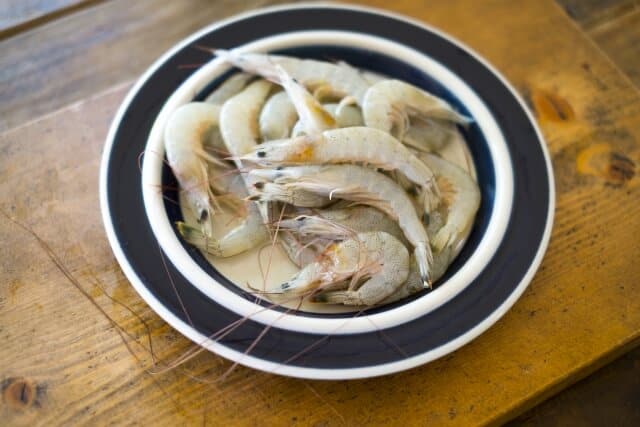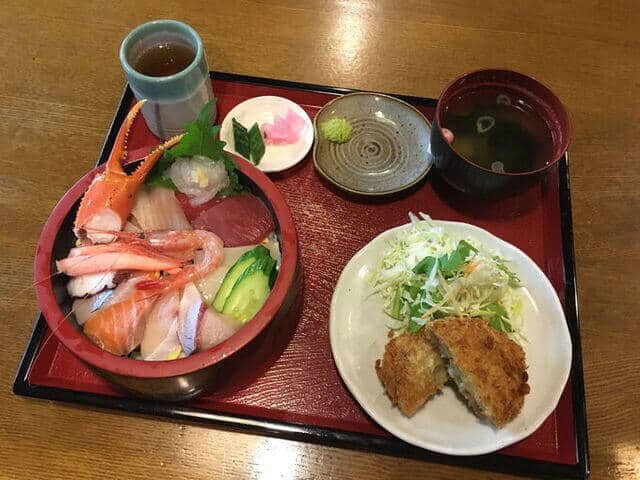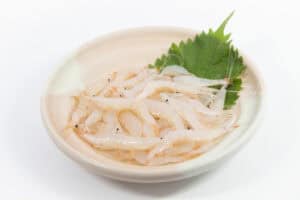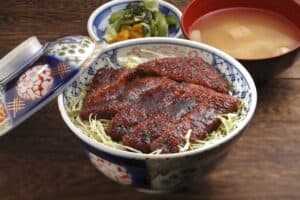In the coastal waters of Japan, where culinary traditions and seafood expertise converge, lies a captivating gem of the ocean known as Shiro Ebi, or “white shrimp.” Beyond its taste and visual appeal, Shiro Ebi carries cultural significance explored through festivals and traditions. Seasonal availability and sustainable practices are also touched upon, highlighting the importance of preserving this marine gem. Join us in unveiling the enchanting world of Shiro Ebi, where Japanese culinary expertise and oceanic treasures combine to create an unforgettable experience for the palate.
What is White shrimp?

Shiro ebi (白エビ) or white shrimp is a type of small, translucent shrimp found in Japan. They named white shrimp due to its pale, almost transparent appearance. These tiny shrimp are commonly found in the waters around Japan, particularly in areas like Toyama Bay on the west coast of Honshu. Locally, they are called by names such as “hirata shrimp”, “shiro shrimp”, and “betsuko shrimp”.
Shiro ebi are known for their delicate and slightly sweet flavor. They are often in Japanese cuisine, particularly in regional dishes. One of the most famous preparations of shiro ebi is “shiro ebi no sashimi,” where the shrimp are served raw as sashimi, sometimes with a bit of wasabi and soy sauce. The transparent nature of shiro ebi makes them visually appealing when used in sashimi. These small shrimp are also in other dishes like tempura, and rice bowls, and as a garnish for various seafood and noodle dishes.
White shrimp History

White shrimp made its serendipitous debut during the early years of the Meiji era when a curious twist of fate unfolded. A fisherman, initially on a cod-catching expedition, inadvertently dropped his net into the profound waters. To his astonishment, upon raising the net, it cradled a captivating white shrimp. This discovery heralded the emergence of the cherished jewel of Toyama Bay, the shiro ebi, an extraordinary find. Today, we owe our introduction to the delectable ways of savoring it to this fortuitous incident. Without the fisherman’s accidental net-drop, this culinary treasure might have remained hidden. Gradually, this chance discovery etched its place as an indispensable ingredient, enriching the gastronomic traditions of Toyama Prefecture.
Where can you catch White Shrimp?

White shrimp thrives in various regions across Japan, extending its distribution not only to Toyama Bay but also encompassing Suruga Bay, Sagami Bay, and the coastal waters off Itoigawa. Toyama Bay is located in Japan, on the northern shores of the Hokuriku region of Honshu, along the Sea of Japan (also known as the East Sea). Situated specifically in the northern part of the Ishikawa Prefecture and the southern part of the Toyama Prefecture. Toyama Bay is known for its scenic beauty, fisheries, and as a gateway to the Japanese Alps, making it a popular destination for tourists and seafood enthusiasts.
However, it’s crucial to note that only Toyama Bay yields a substantial catch, rendering a viable fishery. Furthermore, the catch is limited to specific areas, namely off Shinminato, off Iwase in Toyama City, and off Mizuhashi. These areas are characterized by their deep-sea locations, carved by the estuaries of major rivers, making them the ideal habitat for shiro ebi residing at depths ranging from 100 to 600 meters.
Shape of White Shrimp

It is transparent and has a faint red color. The fresher the fish, the more transparent it becomes, and as it loses its freshness, it becomes cloudy and loses its transparency. It is about 5-8 cm long, has well-developed swimming limbs, and has a pair of long antennae on its head.
Various White Shrimp Dishes
“Shiroebi-don” with raw, tempura, and kakiage

There are many restaurants in Toyama that serve shiro ebi dishes. Among these, the restaurant where you can enjoy a “shiro ebi bowl” at a reasonable price is particularly popular. The sashimi bowl topped with peeled shiro ebi, tempura bowl, and kakiage bowl are all popular for their deliciousness.
White shrimp burger

In Imizu City, Toyama Prefecture, a fast food called Shiroebi Burger is famous. This popular burger suddenly came into the spotlight after being sold at Roadside Station Kamon Park Shinminato and featured on TV and various media. This burger consists of crispy fried shiro ebi topped with tartar sauce and sandwiched between soft buns and also comes with a wasabi flavor.
White shrimp crackers

“Shiraebi Senbei”, which contains shiro ebi, is a popular snack among tourists and is a perfect souvenir from Toyama. There are many shops that sell Shiroebi Senbei, and commonly found in supermarkets as well as souvenir shops in Toyama Prefecture. The crispy rice crackers filled with fragrant white shrimp are known for their deliciousness and just the right amount of salt.
White shrimp FAQ
- What does the White shrimp taste like?
Shiro Ebi is known for its subtly sweet and delicate flavor. The sweetness is similar to that of fresh ocean water, with a hint of natural sweetness that is not overpowering. This mild sweetness is one of the reasons why Shiro Ebi is highly sought after in Japanese culinary traditions.
- When is white shrimp season?
White shrimp fishing takes place over a long period from April to November. Among them, the peak season for shiro ebi fishing is from April to July. During this period, shiro ebi are in season, and the shells are soft and delicious. However, shiro ebi are perishable even when they are in season, so they are frozen almost immediately after being caught.
White shrimp Recipe

White shrimp Ingredients
| Ingredients of White shrimp for 4 persons | Measurement |
|---|---|
| White shrimp | 80g |
| Onion | 100g |
| Pod carrot | 25g |
| Green beans | 25g |
| Frying oil | 100g |
| Flour | 75g |
| Egg | 23g |
| Salt | 2g |
| Liquor | 8g |
How to make White shrimp?
Wash white shrimp with water and drain.
Slice the onions into thin slices, and cut the green beans into diagonal thin slices. Slice the carrot also.
Put flour, a little salt, a little sake, 1/2 egg, and 100 mL of water in a bowl, add the sliced onions and green beans and mix roughly.
Pour oil into a tempura pot and when it reaches 170-180°C, place Step 3 on a ladle, place shiro ebi sprinkled with flour on top as if to decorate, and fry.
Where to buy White shrimp?
Restaurant Tempo (食堂 天保(てんぽ)

You can casually enjoy white shrimp in the 200-year-old earthen storehouse. The shiro ebi seafood bowl is especially popular. There is also a wide selection of other items, making it ideal for families with children and couples.
Masataro (御休処 政太郎)

A lunch and coffee shop nestled in the traditional streets of Iwase. You can spend a relaxing time in the restaurant, which uses an old Japanese-style house while looking out at the garden from the elegant Japanese-style room or the porch.
Kitchen&cafe GARE GARE (カフェ・喫茶)

A cafe where you can casually enjoy shiro ebi, the jewel of Toyama Bay. Many people visit just for the white shrimp oke, which is limited to 8 servings. The limited-edition Lamborghini car displayed in the adjoining garage is also a must-see.
Final Thoughts

From its humble beginnings to its prominent role in Japanese cuisine, Shiro Ebi embodies the rich history and traditions that make Japan’s food culture so captivating. By exploring its origins, flavors, and cultural significance, we hope this article has shed light on the intriguing world of Shiro Ebi, leaving you with a newfound appreciation for this exquisite ingredient and the culinary heritage it represents.
You can check some Japanese dishes such as Ebi furai and Mosaebi that we know you would like to try too.
















Comments